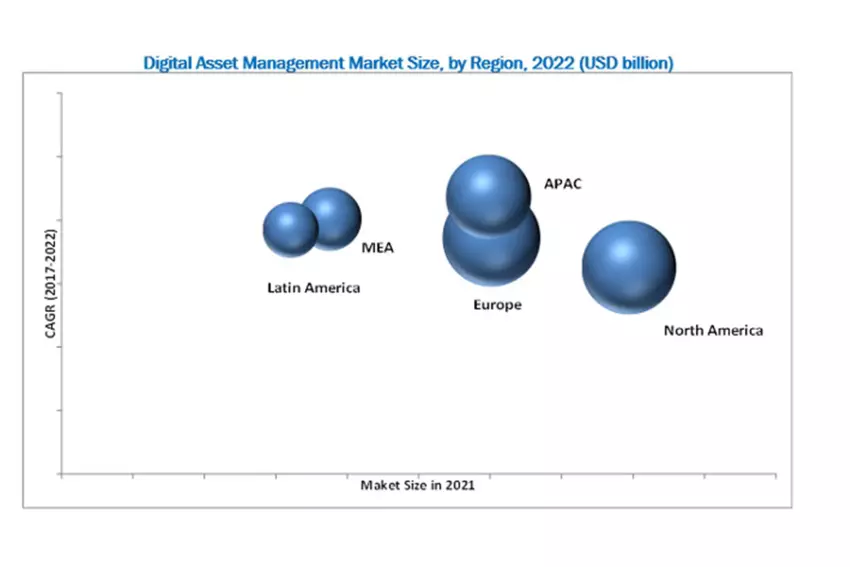A digital asset is a piece of content that’s stored digitally. From images, photos, and text docs to slide decks and graphics, the definition of what constitutes a digital asset is ever-expanding. But what all these assets have in common is their unique value to a company. Some – especially those related to brand identity – are more valuable than others, but all have their worth.
Companies of all shapes and sizes, both B2B and B2C, have to find a way to manage these assets. They must make them as easily searchable and discoverable as possible. Just as HD video conferencing enables people to communicate, a Digital Asset Management solution (DAM) provides a virtual place to store, share, and collaborate.
The Digital Asset Management market reached $3.4 billion in 2019 and it’s expected to grow to $8.4 billion by 2025.

Companies that are adopting DAM systems are seeing many increased benefits in terms of productivity.
The following are five of the most notable:
1. Assets no longer get lost in the system
The rapid growth in both business communication channels and marketing channels has seen an exponential increase in the number of files created. The move toward more inbound-based marketing means campaigns are more personalised and are delivered via multiple resources and channels. Video marketing assuming a prominent role within modern companies has lead to many organizations boasting extensive media libraries.
The result:
A wealth of digital assets even for modest-sized organizations.

For example, imagine a company launches several marketing campaigns every month, via six different channels. Those campaigns are then directed at multiple customer segments and are written in four different languages!
That means thousands of files will be generated.
It will become incredibly difficult to manually search for an elusive presentation, photo, logo, or graph every time a new piece of marketing collateral is required.
With a DAM platform in place, however, all departments can quickly and easily locate images and other digital assets at all times. By storing them and tagging them in the DAM system, it only takes a fraction of the time to find the right assets.
That improved organization also boosts staff morale, since they can focus on the task at hand. This has the knock-on effect of boosting employee retention rates. And, with talented workers becoming more difficult to recruit (as well as expensive) this is a real bonus.
2. A DAM solution enables the quick reuse of assets
Marcom teams often need to reuse the same files in new shapes and sizes to suit each specific channel. This could include scaling an image or photo or cropping the asset so it can fit in various spaces on a page. It could also involve saving a frame from a video or resizing and cutting clips from a master video to use on Facebook or YouTube.
While these aren’t complex tasks in themselves, they often end up requiring a member of the creative team to get involved. This could be expensive, especially if creative tasks are outsourced. By using a DAM solution, the in-house marketing team can handle operations by themself. That’s because they have direct and straightforward access to the relevant files.

All this will lead to the job getting done more quickly and for less money.
A DAM system also avoids duplication of files. Without a centralized DAM, a company has to maintain a mountain of duplicates so that each department has their own media files to use. For example, the PR department keeps their own files, as do the web developers, as do the publications and advertising teams, and
By introducing a DAM solution, companies only need to keep one copy. This will signal the end silos or wasted disk-space and backups, not to mention all the processing involved in creating identical images. It also means that both internal and external teams can access and share the same files.
3. DAMs allow teams to share assets as they’re created
Just as UCaaS brings all forms of business communications together, a DAM system is an effective way to help employees work better together. By being able to share assets and give feedback in real-time – as they’re created – teams can stay on track without having to continually back-up, or redirect.
DAM also negates the tiresome process of having to send out multiple emails for project status updates. The team can stay up to date and see live where the project’s at and what’s happening next.
Team members can simply ‘live look’ at projects – making managing a remote team far easier, so that projects run smoothly.

4. DAMs eliminate the review and editing process
Projects often go through endless rounds of reviews and editing (so much so, that a project can often bears no resemblance to how it looked at the start). This can mean hours per week spent creating and editing documents
Having just one place to store and file work that’s accessible to all team members is invaluable. Editors and senior team members can check in periodically to adjust or add their comments – with everyone immediately becoming aware of the changes. This boosts productivity because with work being completed far quicker.
5. DAMs help avoid bottlenecks
In the traditional content management system, employees have to wait for green lights from managers, which prevents them from continuing with projects. DAM platforms introduce the ability to more easily check in on your team at any time. This eliminates those ‘stop and review’ points. That way, employees can get on with the task at hand (while benefiting from the comments and suggestions from team leaders).

Just as AI is transforming the way people communicate, a DAM system increases cooperation and collaboration between internal and external teams. Since most companies use a mixture of in-house and outsourced suppliers, this makes it easier to bring teams together effectively.
Since everyone is on the same page and can access the same digital assets, less extensive downtime is required to onboard new collaborators.
Final thoughts and takeaways
A Digital Asset Management system can positively impact your organisation in so many ways.DAM streamlines processes, centralises essential company material, and boosts efficiency. DAM software can also increase employee productivity and save your company time and money. With a good DMA solution in place, files become easy to find, and costs are reduced on new designs. That’s true, whether they’re delivered by an outside agency, freelancer, or in-house team.
Projects run more smoothly, because employees no longer have to search time and again for assets. DAM also offers the opportunity to use and reuse materials quickly whenever it’s necessary.
It’s important to note that great DAMs offer all the benefits of a good video hosting platform. With robust video analytics, you’ll be able to keep to track on the exact way videos are interacted with.
Author’s bio:
Sam O’Brien is the Senior Website Optimisation & User Experience Manager for EMEA at RingCentral, a global UCaaS systems provider. Sam has a passion for innovation and loves exploring ways to collaborate more with dispersed teams. He has written for websites such as MultiBriefs and Novatech. Here is his LinkedIn.









